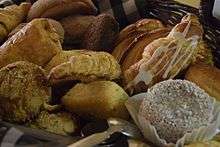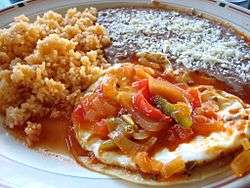Pan dulce
Pan dulce (English: sweet bread) is the name for a variety of Hispanic pastries. The creation of sweet bread was influenced by the French and Spaniards, who introduced baked goods such as crispy rolls, baguettes, and sweet pastries to Central America and Mexico. This inspired the indigenous peoples to create different types of panes dulces such as besos, conchas, and cuernos, among others. The bread is considered to be one of Latin America's most inexpensive treats and is consumed daily as breakfast or late supper, known as merienda.[1]
 Pan dulce at a shop in Mexico City | |
| Type | Sweet bread |
|---|---|
| Place of origin | Latin America |
Types
The creative contribution of French baked goods to Mexico's cuisine peaked in the early 20th century during the dictatorship of Porfirio Diaz. Skilled Mexican bakers adopted French techniques to create new bread designs with colorful names. Today, Mexican bakers are among the most inventive in the world; it is estimated that there are between 500 and 2,000 types of bread currently produced in Mexico.[2][3] Among these are:
- Almohada
- Antaño
- Barquillo
- Barra para rebanadas
- Beso
- Bicicletas
- Bigote
- Bisquet
- Bocado
- Budín
- Burrita
- Calabaza
- Calvo
- Calzón
- Canasta
- Caracol
- Cemita
- Chafaldrana
- Chamuco
- Chicharrón
- Chilindrina
- Chimistlán
- Chirimoya
- Chirindolfo
- Cocoles
- Colchón
- Concha
- Congal
- Coyota
- Cuerno de mantequilla
- Cuerno de vapor
- Donas
- Doroteo
- Elote
- Empanochada
- Galletas de coco
- Gendarme
- Guarapo
- Gusano
- Gusarapo
- Hojaldra
- Ladrillo
- Manita
- Mexicano
- Moño de danés
- Mundos
- Neblina
- Nopal
- Novia
- Ojo de Pancha
- Oreja
- Pachucos
- Pan catarino
- Pan de caja
- Pan de elote
- Pan de feria
- Pan de muerto
- Pan de pueblo
- Pan de pulque
- Pan de royal
- Pan de yema
- Pan decorado con letras
- Pan en forma de corazón
- Pan en forma de tornillo
- Pan mestizo
- Pan redondo bordado
- Pan redondo o moreliano
- Pan típico de nuez
- Panquecito
- Pechuga
- Piedra
- Polvorón
- Puerquito de piloncillo
- Rebanada
- Regañada
- Reja
- Rehiletes
- Rieles
- Rosca de reyes
- Roscas de canela
- Soles
- Tanas
- Tecoyota
- Trenza
- Yolanda
- Yoyos
Besos
A beso (kiss), from Mexico, is made by creating round domes on the top with a drop filling of jam in the middle.[4]
Campechanas
Campechanas are rectangular glazed Mexican pastries, a very common pan dulce.[5]
Conchas (shells)
Conchas (shells) are known for their shell-like shape and sugar shell pattern on the top. It is similar to Japanese melon pan. This is one of the most famous Mexican pastries and widely recognized in the United States. It is also referred to as "pan de huevo" (egg bread) in other Latin American countries, such as Chile, where they are eaten during tea time or at the beach.[6] They are known as cemitas in Honduras.
Cuernos (horns)
Cuernos (horns) are a Mexican pastry that is known for their horn-like shape. This pastry has garnered many comparisons to the French croissant.[7]
Empanadas (turnovers)
Empanadas (turnovers) are a pastry more commonly served in Cuba and South America but also have a place in Mexican cuisine. They are filled with meat or other ingredients such as cheese or vegetables of different sorts. They are also filled with fruit such as pumpkin or apple.[8]
Marianas
Marianas are small vanilla sponge cakes that are coated with raspberry jam and coconut along the outside. The top part of Marianas are usually is filled with icing or fruit filling.[9]
Marranitos / cochinitos / puerquitos (little pigs)
Marranitos / cochinitos / puerquitos (little pigs) are pig-shaped pastries sweetened with piloncillo and spiced with cinnamon. The bread has erroneously been called "gingerbread pig" because the finished result looks similar to gingerbread. However, ginger isn't used to make the pastry.[10]
Orejas (ears)
Orejas (ears) are flaky and sweet Mexican pastries that are shaped like an ear and are very common at bakeries.[11] They are very similar to a French Palmier.
Piedras (rocks or stones)
Piedras (rocks or stones) is a pastry made of old bread and is known to be as hard as a rock. Many people eat this with very hot drinks.[12]
.jpg)
Polvorones (wedding cookies)
Polvorones (wedding cookies) are shortbread cookies, often eaten at weddings.[13]
Yoyos (yo-yos)
Yoyos (yo-yos) are a Mexican pastry named after the yo-yo toy, and is shaped exactly like it, but does not have the string. It has a filling which usually consists of raspberry jam.[14]
For religious occasions/Seasonal pastries
With the invention of pan dulce in Mexico, other significant breads were produced to celebrate special occasions and traditions, such as rosca de reyes and pan de muerto. These special breads are part of the traditional customs that have been around for centuries. The stories behind these special occasional breads derive from religious beliefs, the dominant being Roman Catholic.
Rosca de reyes
Rosca de reyes ('kings' crown') is a treat in addition to a gift that is given on Three Kings Day, Dia de los Reyes Magos, which is held twelve days after Christmas, the celebration date of the birth of Jesus Christ. This bread is symbolic in many ways, the most illustrative being its round shape which signifies the crown of the Reyes Magos; see Biblical Magi. Baked inside is a small white plastic or ceramic figurine which represents the baby Jesus. The hidden baby Jesus symbolizes the secrecy of the location of Jesus as a child. The ruler of Jerusalem, King Herod, upon learning about the birth of the rightful King of Jerusalem, ordered that all male infants be killed so that he could keep his crown. Whoever finds the small figurine is obligated to host a party for the celebration of the Dia de la Candelaria - Fiesta de la Candelaria - which occurs on February 2.[15][16][17] [18][19]
Pan de muerto
Pan de muerto ('bread of the dead') is a special bread that is consumed and offered as a part of the Día de Muertos celebration in October and November. Day of the Dead is a lively and communal commemoration of the dead. Pan de muerto traces its roots back to the Aztec tradition of placing food as offerings on the tombs of the deceased. The food offerings sustained the spirits on their journey to their underworld.[20] The bread takes many different shapes, from skulls to animals to crosses and mummies. The traditional pan de muerto is shaped like a skull, round, with a little ball at the center top to represent a cranium. Following are the four bones to symbolize the four courses of the universe.[21][22] Pan de muerto consists of ingredients such as dry yeast, all purpose flour, eggs, butter and salt.[23]
Cultural significance
Pan dulce is considered to be a Mexican cuisine even though its origins are European. Other countries in Latin America and even Europe have adapted some of Mexico's pastries, but it is in Mexico that the creative new shapes originate. Today, pan dulce is seen in many parts of the United States, especially in places like California and Texas, as a result of migration.
Mexico
In Mexico, pan dulce is typically consumed at breakfast or evening supper. It is usually accompanied by hot chocolate, milk (or warm milk), or coffee, and is dipped into the drink for better taste. It can also be eaten alone. Pan dulce has been an important part of Mexican cuisine since the colonial years when the Spaniards introduced wheat and the French brought crispy baguettes and rich pastries. Traditional local dishes were soon replaced with European cuisine. In addition to its sweet taste, pan dulce is also inexpensive, an incentive for daily consumption.
United States
Pan dulce can be found in Mexican markets in many U.S. states including California, Colorado, Texas, Arizona, Georgia, Nevada, New Mexico, New York, Illinois etc. Though pan dulce may not be consumed as frequently, it is commonly consumed in Latin American homes.
See also
References
- "History of Pan Dulce". laconchabakery.org. Retrieved 6 March 2017.
- "PAN DULCE. WHAT DO YOU CALL THAT?". latinopia.com. Retrieved 6 March 2017.
- "THE HISTORY OF BREAD IN MEXICO". La Monarca Bakery. 2011-09-13. Archived from the original on 13 September 2011. Retrieved 6 March 2017.
- Popik, Barry. "Besos (Mexican pastry "kisses")". barrypopik.com. Retrieved 6 March 2017.
- Popik, Barry. "Campechanas". barrypopik.com. Retrieved 6 March 2017.
- Popik, Barry. "Conchas (Mexican shell-shaped pastries)". barrypopik.com. Retrieved 6 March 2017.
- Popik, Barry. "Cuernos (Mexican horn-shaped pastries)". barrypopik.com. Retrieved 6 March 2017.
- Popik, Barry. "Empanada". barrypopik.com. Retrieved 6 March 2017.
- Popik, Barry (12 December 2008). "Yoyos or Yo-Yos (Mexican Pastries)".
- Popik, Barry. "Marranitos or Cochinitos or Puerquitos (little gingerbread pigs)". barrypopik.com. Retrieved 6 March 2017.
- Popik, Barry. "Orejas (Mexican pastry "ears")". barrypopik.com. Retrieved 6 March 2017.
- Popik, Barry. "Piedras (Mexican pastry "rocks" or "stones")". barrypopik.com. Retrieved 6 March 2017.
- Popik, Barry. "Pan de Polvo or Polvoron/Polvorones (Mexican Wedding Cookies)". barrypopik.com. Retrieved 6 March 2017.
- Popik, Barry. "Yoyos or Yo-Yos (Mexican pastries)". barrypopik.com. Retrieved 6 March 2017.
- "Three King's Day - January 6th - The Story of Los Tres Reyes Magos". mexonline.com. Retrieved 6 March 2017.
- "Rosca de Reyes is a Mexican Tradition". mexgrocer.com. Retrieved 6 March 2017.
- "What is a "Rosca de Reyes"?". adelantemujeres.blogspot.com. Retrieved 6 March 2017.
- Liliana Salomón Meraz (2011-01-02). "Rosca de reyes, historia y receta". archive.org. Archived from the original on 26 February 2013. Retrieved 6 March 2017.CS1 maint: BOT: original-url status unknown (link)
- Gema Candelas Peña (1 January 2011). "El Regalo del Roscón de Reyes" (25). Retrieved 6 March 2017 – via www.interpretaciondelpatrimonio.com. Cite journal requires
|journal=(help) - "Day of the Dead Treats: Pan de Muerto". Serious Eats. Retrieved 6 March 2017.
- Historia del Pan de Muerto - Miércoles - 31 de Octubre de 2012 - Sabor a México
- "Pan de Muertos (Mexican Bread of the Dead) Recipe". allrecipes.com. Retrieved 6 March 2017.
- Andrade, Mary J (2000). Through the Eyes of the Soul, Day of the Dead in Mexico. Hong Kong: La Oferta Review Newspaper, Inc. pp. 107. ISBN 0966587626.
External links
| Wikimedia Commons has media related to Sweet breads of Mexico. |
- Greenleigh, John; Beimler, Rosalind Rosoff (1 January 1991). "The Days of the Dead: Mexico's Festival of Communion with the Departed". Pomegranate. Retrieved 6 March 2017 – via Google Books.
- Herrera-Sobek, María (1 January 2012). "Celebrating Latino Folklore: An Encyclopedia of Cultural Traditions". ABC-CLIO. Retrieved 6 March 2017 – via Google Books.
- Roldán, Aurora (30 November 2004). "50 Recetas de Pan Dulce, Turrones Y Confituras / 50 Receipes of Sweet Breads, Turrones and Confectionaries" (in Spanish). Grulla. Retrieved 6 March 2017 – via Google Books.


.jpg)
